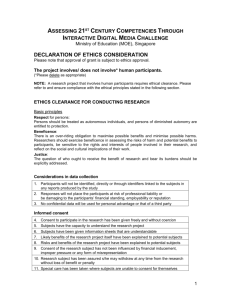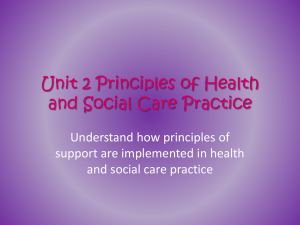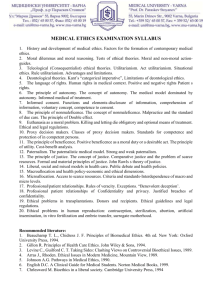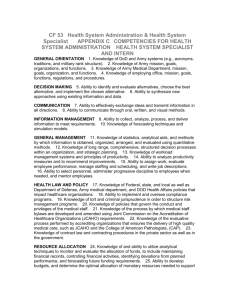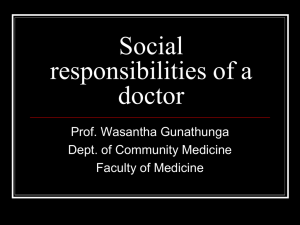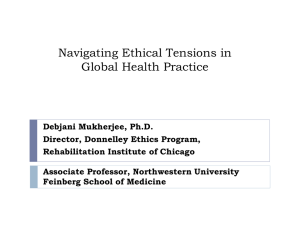9.1-Assessment-Key
advertisement
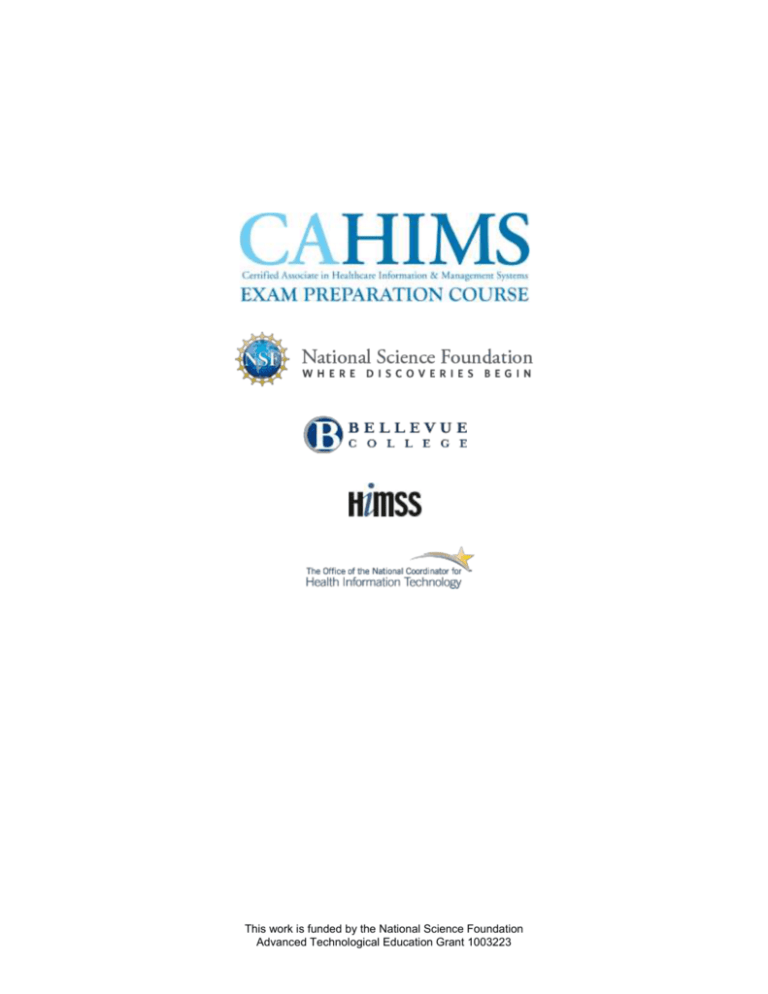
This work is funded by the National Science Foundation Advanced Technological Education Grant 1003223 The CAHIMS Exam Preparation Course and the CAHIMS exam are the result of collaboration between the Life Science Informatics Center at Bellevue College and the Healthcare Information and Management Systems Society (HIMSS). Significant content found in the CAHIMS Exam Preparation Course stems from the Office of the National Coordinator for Health Information Technology. Creation of the CAHIMS Exam Preparation Course and the CAHIMS exam was made possible through support from the National Science Foundation (NSF). Curriculum Team: Margaret Schulte, DBA Michèle Royer, PhD Nathan Savage, MLIS This work is funded by the National Science Foundation Advanced Technological Education Grant 1003223 Section 9 - Professionalism and Communication Skills Lesson 9.1 - Business and Communication Ethics Assessment Questions Answer Key Lectures 1, 2, 3 & 4 1. Which of the following are the 4 core principles of medical ethics? a. Autonomy, beneficence, confidentiality, non-maleficence *b. Autonomy, beneficence, justice, non-maleficence c. Autonomy, beneficence, equality, non-maleficence d. Autonomy, beneficence, non-maleficence, privacy Answer: b. Many people who study healthcare ethics say the basics can be captured in the application of 4 basic ideas: autonomy, beneficence, nonmaleficence, and justice. This approach is widely used and serves as the starting point for many discussions of healthcare ethics. Lecture(s)/Slide(s): 1/4-8, 4/13,14 2. The ethical principle of autonomy implies all of the following EXCEPT: a. Healthcare professionals must get informed consent from patients before treating them. b. Patients have the right to refuse treatment. c. Patients’ medical records must be kept confidential. *d. Treatments must be designed to maximize benefits and minimize risks. Answer: d. It is true that treatments must maximize benefits and minimize risks, but this is implied by the principles of beneficence and non-maleficence, respectively. The principle of autonomy is applied to informed consent, voluntary decision-making, and medical confidentiality. Lecture(s)/Slide(s): 1/5,10, 3/4-6 3. Which of the following is NOT an aspect of professionalism? a. Behaving ethically on the job b. Gaining the technical ability to do a good job c. Learning ethical codes *d. Setting and achieving aspirational goals Answer: d. Professionalism means acting in a way that meets the standards of one’s profession. These standards may incorporate ethical obligations, best practices, and other norms within a profession. By definition, an aspirational goal This work is funded by the National Science Foundation Advanced Technological Education Grant 1003223 Page 1 is a standard that would be met in an ideal world but is not currently achievable in the real world. Lecture(s)/Slide(s): 1/3,13,17-19, 4/6 4. Which of the following is NOT necessary for a successful malpractice lawsuit? *a. The healthcare provider being sued is a doctor. b. The healthcare provider failed to meet minimum standards of care. c. The healthcare provider had a duty to the patient. d. The injury resulted in damages (harm). Answer: a. Other healthcare providers besides doctors, including nurses, pharmacists, and physical therapists, can be successfully sued in a court of law if the elements of a malpractice case are met. Lecture(s)/Slide(s): 2/9,10 Lectures 5 & 6 5. Ethics are considered to be a. behaviors prescribed by law. *b. behaviors based on social standards. c. enforceable by the legal system. d. Judeo-Christian principles. Answer: b. behaviors based on social standards. Lecture(s)/Slide(s): 5/4 6. Policing smoking behavior in enclosed environments for public health reasons would be an ethical practice based on which of the following approaches? a. Justice b. Moral-rights *c. Utilitarian d. Individualism Answer: c. Utilitarian Lecture(s)/Slide(s): 5/7 This work is funded by the National Science Foundation Advanced Technological Education Grant 1003223 Page 2 7. Which of the following is NOT a major role of the medical ethics committee? a. Education b. Reviewing institutional policies on ethical issues c. Case consultation *d. Disciplinary action Answer: d. Disciplinary action Lecture(s)/Slide(s): 5/11 8. Which of the following is considered an external or secondary diversity dimension? a. Race b. Sexual orientation *c. Income d. Age Answer: c. Income Lecture(s)/Slide(s): 6/5 9. The following statement is TRUE with respect to diversity: a. Diversity has more negative than positive consequences. *b. Diversity can be leveraged with the appropriate leadership. c. Diversity can result in more effective communication. d. Diversity can reduce group conflict. Answer: b. Diversity can be leveraged with the appropriate leadership. Lecture(s)/Slide(s): 6/8 10. __________ represents a preference for one’s own culture that results in critical evaluations of people from another culture. *a. Ethnocentrism b. Ethnorelativism c. Pluralism d. Prejudice Answer: a. Ethnocentrism Lecture(s)/Slide(s): 6/9 This work is funded by the National Science Foundation Advanced Technological Education Grant 1003223 Page 3 11. An emphasis on family involvement in healthcare decision making is characteristic of a. low context cultures. b. high context cultures. *c. collectivist cultures. d. individualist cultures. Answer: c. collectivist cultures. Lecture(s)/Slide(s): 6/13 12. An emphasis on building relationships in communication is characteristic of a. low context cultures. *b. high context cultures. c. collectivist cultures. d. individualist cultures. Answer: b. high context cultures. Lecture(s)/Slide(s): 6/14 13. The Civil Rights Act of 1964 prohibits discrimination based on a. age. b. disability. *c. religion. d. sexual orientation. Answer: c. religion. Lecture(s)/Slide(s): 6/16 14. All of the following represent important elements of cultural competency EXCEPT a. Policies, processes and structures for cross-cultural interactions b. Family-centered care c. Equitable care *d. Ethnocentric care Answer: d. Ethnocentric care Lecture(s)/Slide(s): 6/20 This work is funded by the National Science Foundation Advanced Technological Education Grant 1003223 Page 4 15. Culture is defined as: a. Customs and traditions that guide individuals b. Religious belief systems that determine group behavior c. Learned behaviors and beliefs that bond families *d. Communal sharing of a pattern of learned beliefs and behaviors Answer: d. Communal sharing of a pattern of learned beliefs and behaviors Lecture(s)/Slide(s): 6/4 16. Which is the key factor in the cause of cultural differences? *a. Identity b. Race c. Religion d. Nationality Answer: a. Identity Lecture(s)/Slide(s): 6/4 17. Health Valley Hospital’s human resource officer is assigned the task of increasing the marketability of the hospital. Which is the best action for this task? a. Offer employee vacation days for religious holidays *b. Hire a diverse employee base that represents the diversity of the community c. Increase benefits for those who have twenty-five years of service d. Offer incentives for those who attend diversity training Answer: b. Hire a diverse employee base that represents the diversity of the community Lecture(s)/Slide(s): 6/6 18. In order to inhibit the tendency to focus on behavior that reinforces prejudices one should: a. be loyal to the culture of one’s background. b. do not discuss prejudices with coworkers. *c. be aware of stereotyping. d. stay busy at work and evade confrontations. Answer: c. be aware of stereotyping. Lecture(s)/Slide(s): 6/10 This work is funded by the National Science Foundation Advanced Technological Education Grant 1003223 Page 5 19. The following scenario is indicative of which cultural element of communication? Lin looks down when the CEO speaks to her. Bob steps back after being approached by his coworker. Jeremy is surprised by a long handshake. Anna avoids hugs. a. Prudent personal awareness b. Mutual respect *c. Sense of self and space d. Sense of cultural preferences Answer: c. Sense of self and space Lecture(s)/Slide(s): 6/12 20. According to this unit, the term “hidden curriculum” refers to: a. Any way in which a co-worker punishes a whistleblower b. How state medical boards help medical school graduates prepare to re-take the medical board examination after failing once or twice *c. How medical students acquire their ethical standards d. The continuing education classes that doctors must take if a state medical board disciplines them Answer: c. Many experts say that when it comes to prevailing ethical values, medical education contains a “hidden curriculum.” Such things as institutional policies, standards for evaluation, resource-allocation decisions, and institutional language can influence what medical students learn about ethics. Lecture(s)/Slide(s): 6/12-14 This work is funded by the National Science Foundation Advanced Technological Education Grant 1003223 Page 6


